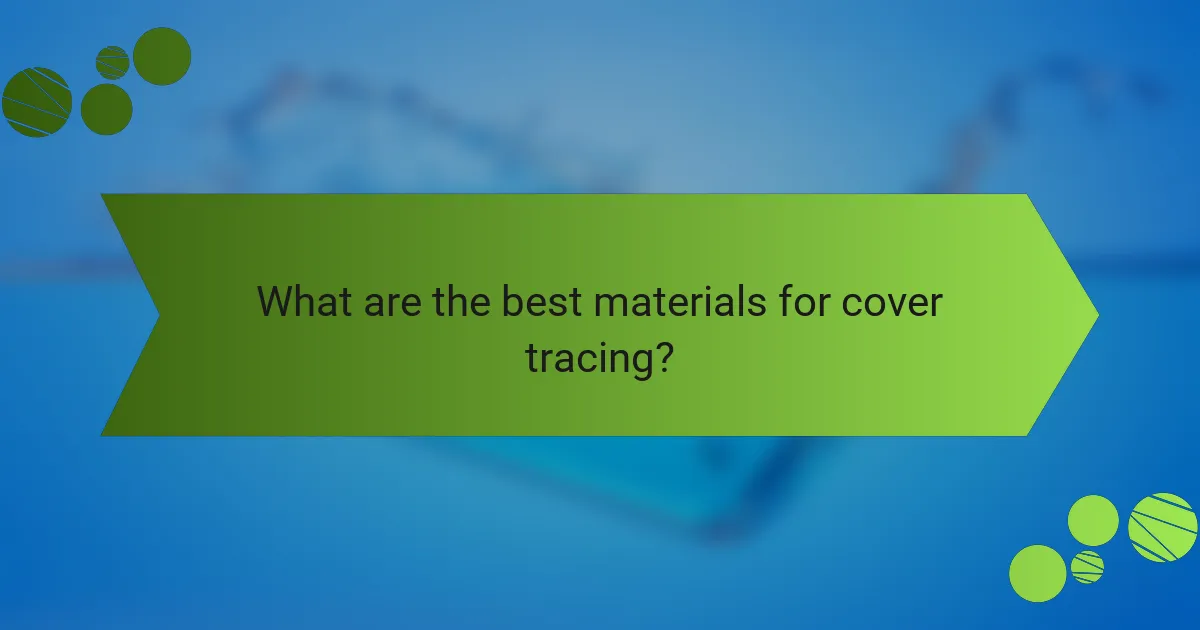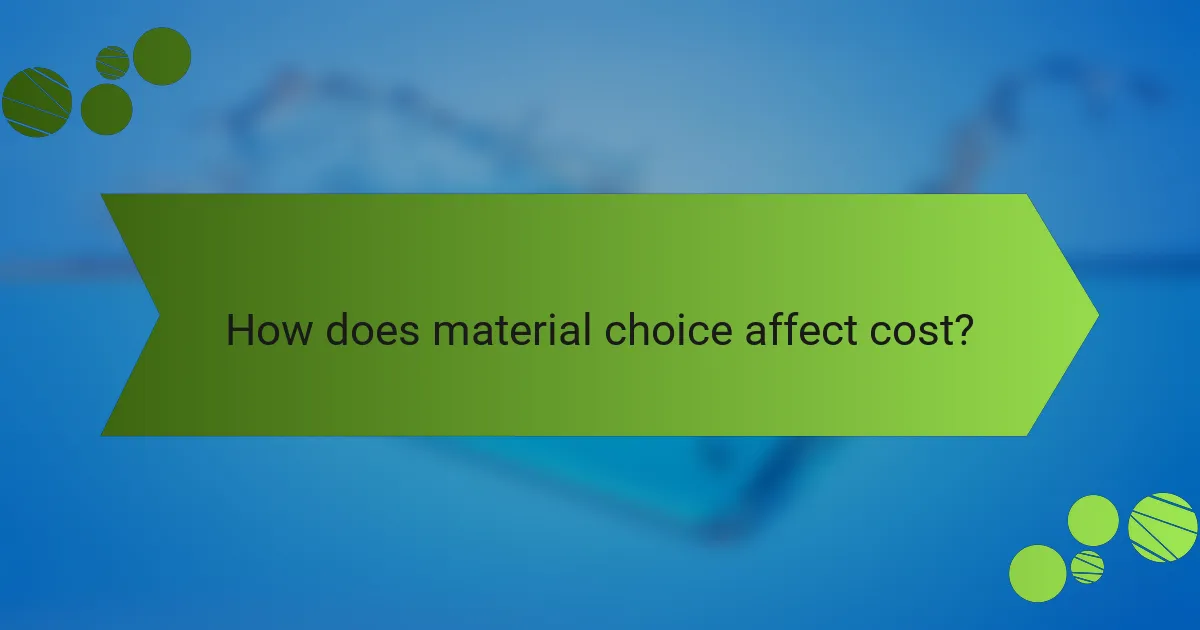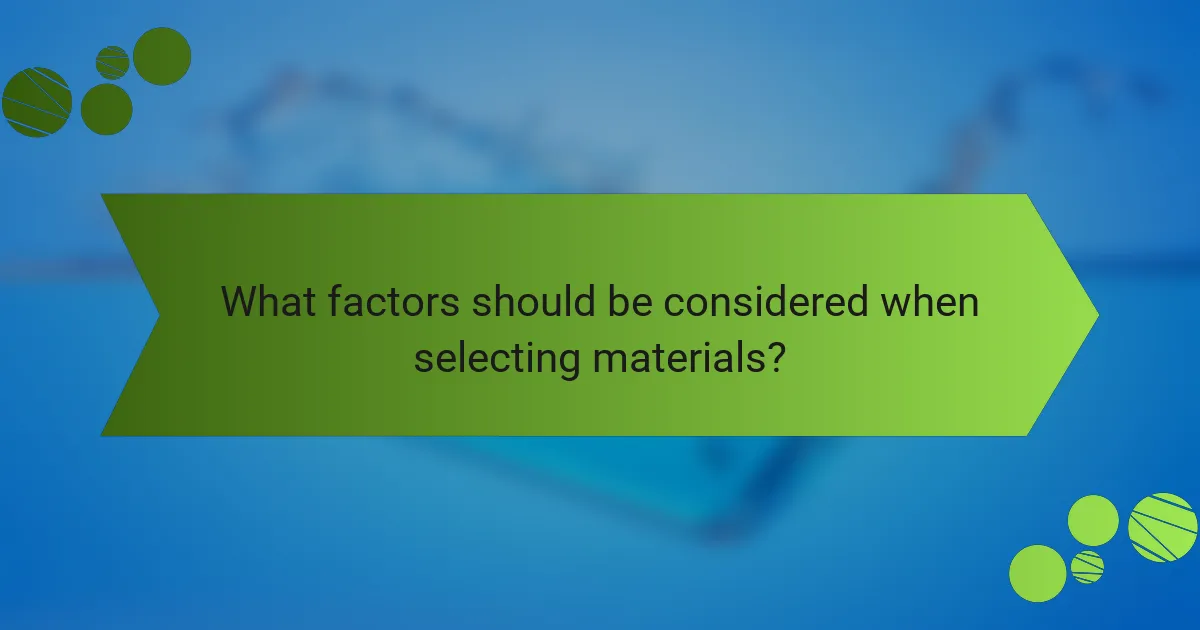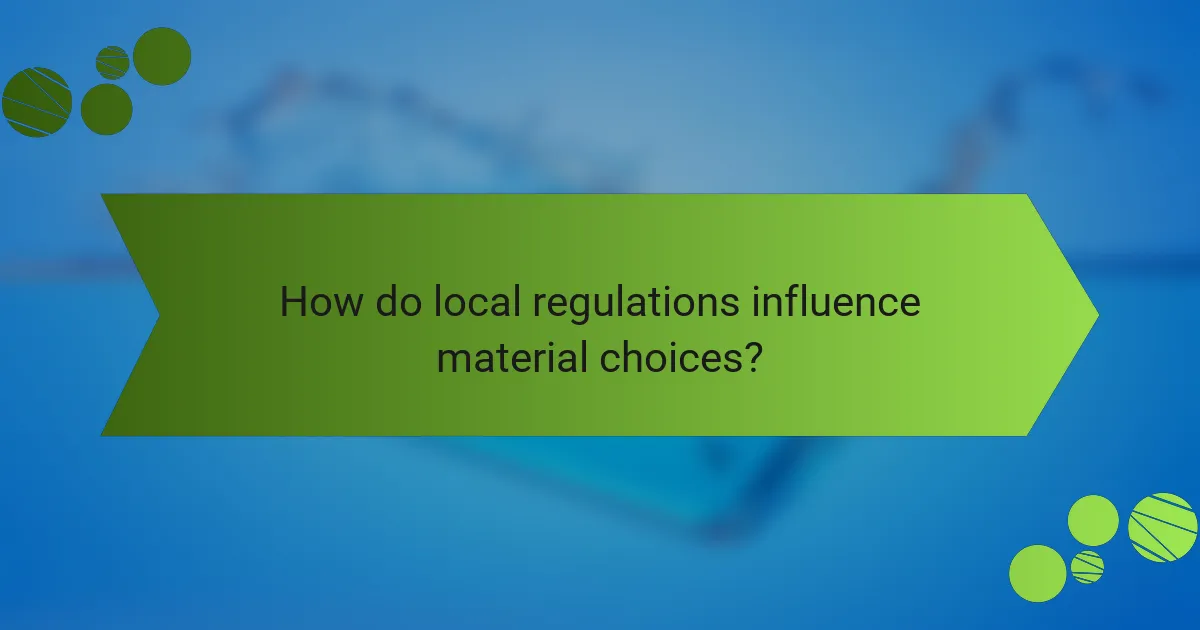Cover tracing is a critical aspect of project planning, where the selection of materials such as polyethylene, polypropylene, vinyl, and paper plays a vital role. Each material presents unique benefits and challenges, influencing both the initial costs and the long-term value of the project. By understanding the properties and implications of these materials, stakeholders can make informed decisions that effectively balance cost and quality.

What are the best materials for cover tracing?
The best materials for cover tracing include polyethylene, polypropylene, vinyl, and paper. Each material offers distinct advantages and considerations regarding durability, flexibility, waterproofing, and cost-effectiveness.
Polyethylene for durability
Polyethylene is a popular choice for cover tracing due to its high durability and resistance to wear and tear. It can withstand various environmental conditions, making it suitable for both indoor and outdoor applications.
This material is often used in heavy-duty projects where longevity is essential. When selecting polyethylene, consider thickness options, as thicker variants provide enhanced protection but may come at a higher cost.
Polypropylene for flexibility
Polypropylene is known for its flexibility, making it ideal for applications that require bending or folding without breaking. This material is lightweight yet strong, allowing for easy handling and transport.
When choosing polypropylene for cover tracing, assess the specific flexibility requirements of your project. It is often available in various colors and finishes, offering aesthetic options alongside functionality.
Vinyl for waterproofing
Vinyl is an excellent choice for waterproof cover tracing, providing a reliable barrier against moisture. This material is particularly useful in environments where exposure to water is a concern, such as outdoor displays or in humid conditions.
When using vinyl, ensure that the thickness is appropriate for your needs, as thicker vinyl offers better waterproofing but may increase costs. Consider the potential for UV exposure as well, as some vinyls are treated to resist fading.
Paper for cost-effectiveness
Paper is the most cost-effective option for cover tracing, making it suitable for short-term projects or budget-conscious applications. It is widely available and can be easily printed or customized for specific needs.
While paper is less durable than other materials, it can be reinforced with coatings or laminates for added protection. Evaluate the expected lifespan and use case to determine if paper meets your project requirements effectively.

How does material choice affect cost?
The choice of materials significantly impacts both the initial costs and the long-term value of a project. Higher-quality materials typically lead to increased upfront expenses but can offer better durability and performance over time.
High-quality materials increase upfront costs
Investing in high-quality materials often results in higher initial costs, which can be a barrier for many projects. For instance, premium fabrics or specialized coatings can cost significantly more than standard options, sometimes by 20-50%. However, these materials may provide superior performance and aesthetics, justifying the higher price tag.
When selecting materials, consider not only the purchase price but also the potential for reduced maintenance and replacement costs. For example, a high-quality cover may last several years longer than a cheaper alternative, making it a more economical choice in the long run.
Long-term savings from durable materials
Durable materials can lead to substantial long-term savings by minimizing the need for repairs and replacements. While the initial investment may be higher, materials like reinforced vinyl or high-grade polyester can withstand wear and tear better than their lower-quality counterparts.
For example, a durable cover made from high-quality materials may last twice as long as a budget option, ultimately saving you money over time. Additionally, these materials often come with warranties that can further protect your investment.
Budget options for short-term projects
For projects with limited budgets or short-term needs, opting for budget materials can be a practical choice. These materials are typically less expensive, making them suitable for temporary applications or projects where longevity is not a primary concern.
However, be cautious when selecting budget options, as they may not perform as well under stress or adverse conditions. It’s essential to assess the specific requirements of your project and determine whether a lower-cost material will meet your needs without compromising quality.

What are the quality implications of different materials?
The quality of cover tracing materials significantly affects their performance, longevity, and suitability for specific applications. Understanding the properties of materials like polyethylene, polypropylene, and vinyl can help in making informed decisions that balance cost and quality.
Durability and lifespan of polyethylene
Polyethylene is known for its excellent durability, making it a popular choice for cover tracing. It typically lasts several years under normal conditions, resisting wear and tear effectively. However, exposure to UV light can degrade its quality, so consider UV-stabilized options for outdoor applications.
When evaluating polyethylene, look for thickness and density, as these factors directly influence its lifespan. Thicker materials generally provide better protection and durability, making them suitable for heavy-duty use.
Flexibility and application of polypropylene
Polypropylene offers superior flexibility compared to other materials, allowing it to conform easily to various shapes and surfaces. This adaptability makes it ideal for applications requiring intricate designs or tight fits. Its lightweight nature also contributes to ease of handling and installation.
However, while polypropylene is flexible, it may not be as durable as polyethylene in harsh environments. Consider the specific application needs, such as temperature fluctuations and mechanical stress, when choosing polypropylene for cover tracing.
Water resistance of vinyl
Vinyl is highly regarded for its water resistance, making it an excellent choice for applications exposed to moisture. It effectively prevents water penetration, which is crucial for protecting underlying materials and maintaining structural integrity.
When selecting vinyl, check for its thickness and quality ratings, as these factors determine its effectiveness in water resistance. Additionally, vinyl can be treated with additives to enhance its resistance to mold and mildew, further extending its lifespan in wet conditions.

What factors should be considered when selecting materials?
When selecting materials for cover tracing, consider durability, cost, and the intended use of the product. Each material has unique properties that can affect the overall quality and longevity of the cover, influencing both performance and budget.
Project requirements and usage
Understanding the specific requirements of your project is crucial when choosing materials. For instance, if the cover will be exposed to harsh environmental conditions, opt for weather-resistant materials like vinyl or heavy-duty plastics. In contrast, for indoor applications, lighter materials such as paper or fabric may suffice.
Consider the intended usage as well. If the cover needs to withstand frequent handling or transportation, prioritize materials that offer greater durability and flexibility. This can prevent premature wear and reduce replacement costs over time.
Environmental impact of materials
The environmental impact of materials is an increasingly important consideration. Opt for sustainable options, such as recycled or biodegradable materials, to minimize your ecological footprint. Many manufacturers now offer eco-friendly alternatives that meet quality standards without compromising performance.
Additionally, assess the lifecycle of the materials you choose. Some materials may have a higher upfront cost but can lead to lower long-term environmental impact due to their durability and recyclability. Always check for certifications that indicate compliance with environmental regulations, which can guide your selection process.

How do local regulations influence material choices?
Local regulations significantly shape material choices for cover tracing by establishing standards that ensure safety, sustainability, and compatibility with existing structures. Understanding these regulations is crucial for selecting appropriate materials that meet both legal requirements and project goals.
Compliance with building codes
Building codes dictate the minimum standards for construction practices, including materials used in cover tracing. These codes often specify fire resistance, structural integrity, and environmental impact, which can limit options to those that have been tested and approved for safety and performance.
For example, in many regions, materials like certain types of plastics may be restricted due to flammability concerns, while concrete and steel are often favored for their durability and compliance with safety standards. Always consult local building authorities to ensure your material choices align with current codes.
Restrictions on certain materials
Local regulations may impose restrictions on specific materials based on environmental or health considerations. For instance, materials containing harmful chemicals or those that do not meet sustainability criteria may be banned or require special permits for use.
In the European Union, for example, regulations like REACH (Registration, Evaluation, Authorisation and Restriction of Chemicals) impact the selection of materials for cover tracing by limiting substances that can be used in construction. It’s essential to verify the compliance of materials with local regulations to avoid costly delays or penalties.


